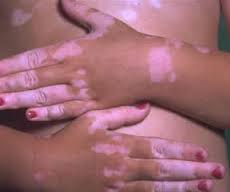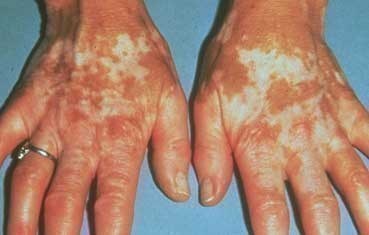
Vitiligo is not harmful to the health – there is no physical pain or irritation – it is merely an absence of pigment in patches (lesions). This means that it is a condition that is merely symptomatic. The reasons treatment for the condition is so sought after is two-fold. First, the white skin is not protected from the sun, which makes it vulnerable to burning. This lack of skin protection can also have long-term health consequences– most notably, the increased risk of skin cancer. The other, more immediate effect is the social and psychological embarrassment.
People with depigmented skin on the face appear odd, especially if their normal skin is of darker complexion. Vitiligo can appear on any part of the body (and sometimes all of it) and is not always easy to hide. Arms, hands and face are typical problem areas, affecting a sufferer’s self-confidence.
While we all have flaws on our body that we are not happy with, they are rarely as eye-catching as vitiligo. It’s not as common as obesity, but, like obesity, it does not garner sympathy. Due to the lack of education, people tend to stare or ask ill-informed questions.
Vitiligo sufferers can go a lifetime feeling unattractive or unworthy purely because of the color of their skin. There are certain societies, such as in parts of India, where a man can divorce his wife if she develops vitiligo. One can easily shield from the sun but not from the opinions of others, even just the perceived opinions of others.
There has been no definitive cause found. The signs point to an auto-immune condition, as it is often accompanied by thyroid problems and familial links are common. The theory here is that the body’s own immune system attacks the melanocytes in the skin. Sometimes it pools around the hair follicle but sometimes even the hair loses its pigmentation. Sometimes it is symmetrical, sometimes it is not. For some reason the asymmetrical type is slower to spread but less reactive to treatment. While theories abound, a definitive reason for this has yet to be discovered.
So, despite the prevalence of the condition, and the amount of research conducted on the matter, no one treatment has been shown to be more effective or suited to all sufferers. What may completely cure one person’s vitiligo may just as easily have no effect on the other, or even have negative effects. Dr Boissy explains, “The health care provider or the patient has no clue as to how the disease will progress in a patient, or how they will respond to the various treatments.” And unfortunately, cures can only ever be seen as temporary, with resurgences common months or years after treatment has ended: “In general, current therapies can only provide repigmentation to about 60% of patients, with only about 60% of lesional area repigmenting, and only about 60% of pigmentation being permanent (while additional new lesions may frequently arise).”
There are a variety of ways that people react to having the condition. Of high importance to some, particularly those who have it on the face, is to cover up the effects. This can be done with medical camouflage, available on the NHS. A specialist will match up your skin tone to a kind of hard-wearing make up and teach you to apply it yourself. This does not solve the problem medically or psychologically, but can certainly help those who feel particularly insecure about the visual impact of vitiligo.
A topical treatment is usually the first port of call in the treatment of vitiligo in the attempts to remove or at least stop the spread of the condition. This is provided in the form of corticosteroids and, as with most steroids, there are some side effects with prolonged use, such as thinning and streaking of the skin. These steroids are not so effective as the more robust light therapy treatments.
PUVA is the one of the more extreme but successful methods of treatment and is a form of light therapy. This treatment involves the ingestion of psoralen, a medicine that makes one’s skin more photosensitive, before exposing the affected areas with UVA. Due to this particularly unprotected exposure to pure UVA, these treatments do have the unfortunate result of increasing the patient’s risk of skin cancer. This is why it is recommended only to those with wide vitiligo coverage and with people with much darker skin, where the vitiligo is much more noticeable.
It is the only form of light therapy available on the NHS, but is certainly something that one should think about carefully before undergoing, due to the long-term skin damage. This was a treatment that I was denied in my teens for which I am, some time later, extremely grateful.
UVB Narrowband Phototherapy is the newest and seemingly most effective method of treatment for vitiligo. It is in fact so new that it is not available on the NHS. Still, Dr Boissy describes it as ‘the most effective phototherapy method available’ and is not too arduous on the patient
If these light therapy treatments do not prove effective, further treatment becomes a lot more drastic. A patient might choose to undergo skin grafts, whereby healthy skin from one area will be attached to the white skin in another. This is not always successful, very time-consuming and can lead to scarring, so is seen as something of a last resort. So too is depigmentation, where the rest of the skin is turned white to match the vitiligo lesions. This is done in order that the patient can be all one colour again, even if it is all white.
This process can take one to four years and involves the daily application of a lotion called Benoquin. This may seem like a drastic manoeuvre but this is the effect that vitiligo can have. The patient wants to be whole again, even if it is a slightly different whole. It is heartening to read Dr Aaron B Lerner’s (Yale University School of Medicine) testament that, “I have never had a patient who was unhappy after being depigmented.” Still, there is no denying that this is a big change, and as with all vitiligo treatments, not without its side effects, such as repigmentation and the very real social issues that come with completely changing one’s skin colour.
Several holistic treatments are also felt to have a positive effect on the repigmentation of vitiligo lesions. Piperine, a product derived from black pepper, has recently gained prominence in the treatment of vitiligo. Dr Boissy is, however, less sure: although here are several basic science studies on the promotional capacity of piperine on melanocyte proliferation and activity, there are no clinical studies on the use of piperine in the literature confirming its putative effectiveness.” Similarly, gingko biloba, though cited by some as a natural treatment for vitiligo because if its relation to the thyroid, has not been put to the clinical test, so evidence of its success is merely anecdotal.
It is easy for someone with vitiligo to feel somewhat alone and uncared for. The condition is not seen as a major health risk and psychological, social and even sexual effects that are debilitating to the subject, are not quickly recognized by doctors or the general public. Relatively little research is put into treatment, and sufferers often feel as though they are not being taken seriously. However, an online community has been building over the past years, building a network of vitiligo sufferers to help support one another where this support may not be available.
Vitiligo Friends is one of the biggest and blends an informative database of case studies and treatment with MySpace-style profiles and busy message boards. It is a place to go to vent your frustrations at the condition, confide your worries and to console others. It is encouraging to see how supportive users are to each other and must have made a big contribution to easing the worry of vitiligo sufferers worldwide. A similar network is available in the UK specifically, called the Vitiligo Society, which even commissions its own research into treatments.
All of this, the various physical treatments and the psychological support, can help in dealing with vitiligo. It is a frustrating and worrying process, not knowing where your vitiligo will spread to next, if this a treatment will work or if the cure will even last. It is horrible feeling unattractive. It is deeply upsetting to be so wary of the sun and, when feeling vulnerable, to have one’s worries ignored or dismissed. And the treatments and support can help with all of this, to a degree. The final aspect, something that it seems comes with time, is to accept the vitiligo as part of yourself and embrace it.
Responses to vitiligo, to its treatment, to its cures all vary hugely from person to person, but Dr Boissy agrees that what does not vary is that the best attitude towards dealing with vitiligo is a sensible approach to sun protection and a healthy body image.
For myself, I feel I am nearly there. I stopped pestering my dermatologist for treatment years ago and stopped wearing camouflage not long after. I’m still cautious in the sun and sometimes when I see photos of myself all I see are the lesions on my face but mostly I forget it’s there. When I allow my facial hair to grow I look like a badger, and I love that now. My perspectives on the world in general, are ever so slightly different to what they might otherwise have been and all the richer for it.
Read more at Vitiligo Cure Information
 Vitiligo is a long term skin disorder that produces white depigmentation patches in certain areas of the skin. In this skin condition the melanocytes which are the cells that make pigment in the skin are destroyed. Studies show that this skin order affects at least one in every hundred people in countries worldwide. This skin condition can begin at any age, but research shows that about fifty percent of vitiligo patients develop it before the age of twenty five.
Vitiligo is a long term skin disorder that produces white depigmentation patches in certain areas of the skin. In this skin condition the melanocytes which are the cells that make pigment in the skin are destroyed. Studies show that this skin order affects at least one in every hundred people in countries worldwide. This skin condition can begin at any age, but research shows that about fifty percent of vitiligo patients develop it before the age of twenty five.



